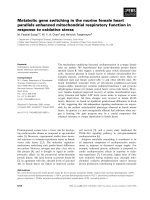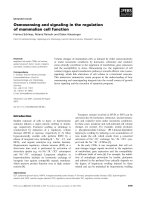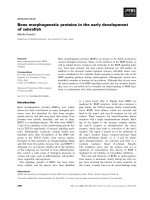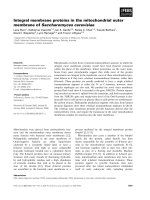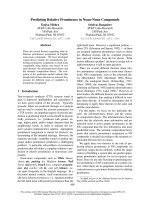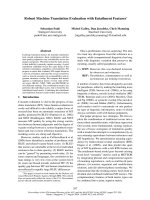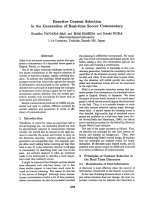Báo cáo khoa học: "Personalising speech-to-speech translation in the EMIME project" pptx
Bạn đang xem bản rút gọn của tài liệu. Xem và tải ngay bản đầy đủ của tài liệu tại đây (706.3 KB, 6 trang )
Proceedings of the ACL 2010 System Demonstrations, pages 48–53,
Uppsala, Sweden, 13 July 2010.
c
2010 Association for Computational Linguistics
Personalising speech-to-speech translation in the EMIME project
Mikko Kurimo
1†
, William Byrne
6
, John Dines
3
, Philip N. Garner
3
, Matthew Gibson
6
,
Yong Guan
5
, Teemu Hirsim
¨
aki
1
, Reima Karhila
1
, Simon King
2
, Hui Liang
3
, Keiichiro
Oura
4
, Lakshmi Saheer
3
, Matt Shannon
6
, Sayaka Shiota
4
, Jilei Tian
5
, Keiichi Tokuda
4
,
Mirjam Wester
2
, Yi-Jian Wu
4
, Junichi Yamagishi
2
1
Aalto University, Finland,
2
University of Edinburgh, UK,
3
Idiap Research Institute,
Switzerland,
4
Nagoya Institute of Technology, Japan,
5
Nokia Research Center Beijing, China,
6
University of Cambridge, UK
†
Corresponding author:
Abstract
In the EMIME project we have studied un-
supervised cross-lingual speaker adapta-
tion. We have employed an HMM statisti-
cal framework for both speech recognition
and synthesis which provides transfor-
mation mechanisms to adapt the synthe-
sized voice in TTS (text-to-speech) using
the recognized voice in ASR (automatic
speech recognition). An important ap-
plication for this research is personalised
speech-to-speech translation that will use
the voice of the speaker in the input lan-
guage to utter the translated sentences in
the output language. In mobile environ-
ments this enhances the users’ interaction
across language barriers by making the
output speech sound more like the origi-
nal speaker’s way of speaking, even if she
or he could not speak the output language.
1 Introduction
A mobile real-time speech-to-speech translation
(S2ST) device is one of the grand challenges in
natural language processing (NLP). It involves
several important NLP research areas: auto-
matic speech recognition (ASR), statistical ma-
chine translation (SMT) and speech synthesis, also
known as text-to-speech (TTS). In recent years
significant advance have also been made in rele-
vant technological devices: the size of powerful
computers has decreased to fit in a mobile phone
and fast WiFi and 3G networks have spread widely
to connect them to even more powerful computa-
tion servers. Several hand-held S2ST applications
and devices have already become available, for ex-
ample by IBM, Google or Jibbigo
1
, but there are
still serious limitations in vocabulary and language
selection and performance.
When an S2ST device is used in practical hu-
man interaction across a language barrier, one fea-
ture that is often missed is the personalization of
the output voice. Whoever speaks to the device in
what ever manner, the output voice always sounds
the same. Producing high-quality synthesis voices
is expensive and even if the system had many out-
put voices, it is hard to select one that would sound
like the input voice. There are many features in the
output voice that could raise the interaction expe-
rience to a much more natural level, for example,
emotions, speaking rate, loudness and the speaker
identity.
After the recent development in hidden Markov
model (HMM) based TTS, it has become possi-
ble to adapt the output voice using model trans-
formations that can be estimated from a small
number of speech samples. These techniques, for
instance the maximum likelihood linear regres-
sion (MLLR), are adopted from HMM-based ASR
where they are very powerful in fast adaptation of
speaker and recording environment characteristics
(Gales, 1998). Using hierarchical regression trees,
the TTS and ASR models can further be coupled
in a way that enables unsupervised TTS adaptation
(King et al., 2008). In unsupervised adaptation
samples are annotated by applying ASR. By elimi-
nating the need for human intervention it becomes
possible to perform voice adaptation for TTS in
almost real-time.
The target in the EMIME project
2
is to study
unsupervised cross-lingual speaker adaptation for
S2ST systems. The first results of the project have
1
2
48
been, for example, to bridge the gap between the
ASR and TTS (Dines et al., 2009), to improve
the baseline ASR (Hirsim
¨
aki et al., 2009) and
SMT (de Gispert et al., 2009) systems for mor-
phologically rich languages, and to develop robust
TTS (Yamagishi et al., 2010). The next step has
been preliminary experiments in intra-lingual and
cross-lingual speaker adaptation (Wu et al., 2008).
For cross-lingual adaptation several new methods
have been proposed for mapping the HMM states,
adaptation data and model transformations (Wu et
al., 2009).
In this presentation we can demonstrate the var-
ious new results in ASR, SMT and TTS. Even
though the project is still ongoing, we have an
initial version of mobile S2ST system and cross-
lingual speaker adaptation to show.
2 Baseline ASR, TTS and SMT systems
The baseline ASR systems in the project are devel-
oped using the HTK toolkit (Young et al., 2001)
for Finnish, English, Mandarin and Japanese. The
systems can also utilize various real-time decoders
such as Julius (Kawahara et al., 2000), Juicer at
IDIAP and the TKK decoder (Hirsim
¨
aki et al.,
2006). The main structure of the baseline sys-
tems for each of the four languages is similar and
fairly standard and in line with most other state-of-
the-art large vocabulary ASR systems. Some spe-
cial flavors for have been added, such as the mor-
phological analysis for Finnish (Hirsim
¨
aki et al.,
2009). For speaker adaptation, the MLLR trans-
formation based on hierarchical regression classes
is included for all languages.
The baseline TTS systems in the project utilize
the HTS toolkit (Yamagishi et al., 2009) which
is built on top of the HTK framework. The
HMM-based TTS systems have been developed
for Finnish, English, Mandarin and Japanese. The
systems include an average voice model for each
language trained over hundreds of speakers taken
from standard ASR corpora, such as Speecon
(Iskra et al., 2002). Using speaker adaptation
transforms, thousands of new voices have been
created (Yamagishi et al., 2010) and new voices
can be added using a small number of either su-
pervised or unsupervised speech samples. Cross-
lingual adaptation is possible by creating a map-
ping between the HMM states in the input and the
output language (Wu et al., 2009).
Because the resources of the EMIME project
have been focused on ASR, TTS and speaker
adaptation, we aim at relying on existing solu-
tions for SMT as far as possible. New methods
have been studied concerning the morphologically
rich languages (de Gispert et al., 2009), but for the
S2ST system we are currently using Google trans-
late
3
.
3 Demonstrations to show
3.1 Monolingual systems
In robust speech synthesis, a computer can learn
to speak in the desired way after processing only a
relatively small amount of training speech. The
training speech can even be a normal quality
recording outside the studio environment, where
the target speaker is speaking to a standard micro-
phone and the speech is not annotated. This differs
dramatically from conventional TTS, where build-
ing a new voice requires an hour or more careful
repetition of specially selected prompts recorded
in an anechoic chamber with high quality equip-
ment.
Robust TTS has recently become possible us-
ing the statistical HMM framework for both ASR
and TTS. This framework enables the use of ef-
ficient speaker adaptation transformations devel-
oped for ASR to be used also for the TTS mod-
els. Using large corpora collected for ASR, we can
train average voice models for both ASR and TTS.
The training data may include a small amount of
speech with poor coverage of phonetic contexts
from each single speaker, but by summing the ma-
terial over hundreds of speakers, we can obtain
sufficient models for an average speaker. Only a
small amount of adaptation data is then required to
create transformations for tuning the average voice
closer to the target voice.
In addition to the supervised adaptation us-
ing annotated speech, it is also possible to em-
ploy ASR to create annotations. This unsu-
pervised adaptation enables the system to use a
much broader selection of sources, for example,
recorded samples from the internet, to learn a new
voice.
The following systems will demonstrate the re-
sults of monolingual adaptation:
1. In EMIME Voice cloning in Finnish and En-
glish the goal is that the users can clone their
own voice. The user will dictate for about
3
49
Figure 1: Geographical representation of HTS voices trained on ASR corpora for EMIME projects.
Blue markers show male speakers and red markers show female speakers. Available online via
/>10 minutes and then after half an hour of
processing time, the TTS system has trans-
formed the average model towards the user’s
voice and can speak with this voice. The
cloned voices may become especially valu-
able, for example, if a person’s voice is later
damaged in an accident or by a disease.
2. In EMIME Thousand voices map the goal is
to browse the world’s largest collection of
synthetic voices by using a world map in-
terface (Yamagishi et al., 2010). The user
can zoom in the world map and select any
voice, which are organized according to the
place of living of the adapted speaker, to ut-
ter the given sentence. This interactive ge-
ographical representation is shown in Figure
1. Each marker corresponds to an individual
speaker. Blue markers show male speakers
and red markers show female speakers. Some
markers are in arbitrary locations (in the cor-
rect country) because precise location infor-
mation is not available for all speakers. This
geographical representation, which includes
an interactive TTS demonstration of many of
the voices, is available from the URL pro-
vided. Clicking on a marker will play syn-
thetic speech from that speaker
4
. As well as
4
Currently the interactive mode supports English and
Spanish only. For other languages this only provides pre-
being a convenient interface to compare the
many voices, the interactive map is an attrac-
tive and easy-to-understand demonstration of
the technology being developed in EMIME.
3. The models developed in the HMM frame-
work can be demonstrated also in adapta-
tion of an ASR system for large-vocabulary
continuous speech recognition. By utilizing
morpheme-based language models instead of
word-based models the Finnish ASR system
is able to cover practically an unlimited vo-
cabulary (Hirsim
¨
aki et al., 2006). This is
necessary for morphologically rich languages
where, due to inflection, derivation and com-
position, there exists so many different word
forms that word based language modeling be-
comes impractical.
3.2 Cross-lingual systems
In the EMIME project the goal is to learn cross-
lingual speaker adaptation. Here the output lan-
guage ASR or TTS system is adapted from speech
samples in the input language. The results so far
are encouraging, especially for TTS: Even though
the cross-lingual adaptation may somewhat de-
grade the synthesis quality, the adapted speech
now sounds more like the target speaker. Sev-
eral recent evaluations of the cross-lingual speaker
synthesised examples, but we plan to add an interactive type-
in text-to-speech feature in the near future.
50
Figure 2: All English HTS voices can be used as online TTS on the geographical map.
adaptation methods can be found in (Gibson et al.,
2010; Oura et al., 2010; Liang et al., 2010; Oura
et al., 2009).
The following systems have been created to
demonstrate cross-lingual adaptation:
1. In EMIME Cross-lingual Finnish/English
and Mandarin/English TTS adaptation the
input language sentences dictated by the user
will be used to learn the characteristics of her
or his voice. The adapted cross-lingual model
will be used to speak output language (En-
glish) sentences in the user’s voice. The user
does not need to be bilingual and only reads
sentences in their native language.
2. In EMIME Real-time speech-to-speech mo-
bile translation demo two users will interact
using a pair of mobile N97 devices (see Fig-
ure 3). The system will recognize the phrase
the other user is speaking in his native lan-
guage and translate and speak it in the native
language of the other user. After a few sen-
tences the system will have the speaker adap-
tation transformations ready and can apply
them in the synthesized voices to make them
sound more like the original speaker instead
of a standard voice. The first real-time demo
version is available for the Mandarin/English
language pair.
3. The morpheme-based translation system for
Finnish/English and English/Finnish can be
compared to a word based translation for
arbitrary sentences. The morpheme-based
approach is particularly useful for language
pairs where one or both languages are mor-
phologically rich ones where the amount and
complexity of different word forms severely
limits the performance for word-based trans-
lation. The morpheme-based systems can
learn translation models for phrases where
morphemes are used instead of words (de
Gispert et al., 2009). Recent evaluations (Ku-
rimo et al., 2009) have shown that the perfor-
mance of the unsupervised data-driven mor-
pheme segmentation can rival the conven-
tional rule-based ones. This is very useful if
hand-crafted morphological analyzers are not
available or their coverage is not sufficient for
all languages.
Acknowledgments
The research leading to these results was partly
funded from the European Communitys Seventh
51
ASR SMT TTS
Cross-lingual
Speaker adaptation
Speaker
adaptation
input
output
speech
Figure 3: EMIME Real-time speech-to-speech
mobile translation demo
Framework Programme (FP7/2007-2013) under
grant agreement 213845 (the EMIME project).
References
A. de Gispert, S. Virpioja, M. Kurimo, and W. Byrne.
2009. Minimum Bayes risk combination of transla-
tion hypotheses from alternative morphological de-
compositions. In Proc. NAACL-HLT.
J. Dines, J. Yamagishi, and S. King. 2009. Measur-
ing the gap between HMM-based ASR and TTS. In
Proc. Interspeech ’09, Brighton, UK.
M. Gales. 1998. Maximum likelihood linear transfor-
mations for HMM-based speech recognition. Com-
puter Speech and Language, 12(2):75–98.
M. Gibson, T. Hirsim
¨
aki, R. Karhila, M. Kurimo,
and W. Byrne. 2010. Unsupervised cross-lingual
speaker adaptation for HMM-based speech synthe-
sis using two-pass decision tree construction. In
Proc. of ICASSP, page to appear, March.
T. Hirsim
¨
aki, M. Creutz, V. Siivola, M. Kurimo, S.
Virpioja, and J. Pylkk
¨
onen. 2006. Unlimited vo-
cabulary speech recognition with morph language
models applied to finnish. Computer Speech & Lan-
guage, 20(4):515–541, October.
T. Hirsim
¨
aki, J. Pylkk
¨
onen, and M Kurimo. 2009.
Importance of high-order n-gram models in morph-
based speech recognition. IEEE Trans. Audio,
Speech, and Language Process., 17:724–732.
D. Iskra, B. Grosskopf, K. Marasek, H. van den
Heuvel, F. Diehl, and A. Kiessling. 2002.
SPEECON speech databases for consumer devices:
Database specification and validation. In Proc.
LREC, pages 329–333.
T. Kawahara, A. Lee, T. Kobayashi, K. Takeda,
N. Minematsu, S. Sagayama, K. Itou, A. Ito, M. Ya-
mamoto, A. Yamada, T. Utsuro, and K. Shikano.
2000. Free software toolkit for japanese large vo-
cabulary continuous speech recognition. In Proc.
ICSLP-2000, volume 4, pages 476–479.
S. King, K. Tokuda, H. Zen, and J. Yamagishi. 2008.
Unsupervised adaptation for HMM-based speech
synthesis. In Proc. Interspeech 2008, pages 1869–
1872, September.
Mikko Kurimo, Sami Virpioja, Ville T. Turunen,
Graeme W. Blackwood, and William Byrne. 2009.
Overview and results of Morpho Challenge 2009. In
Working Notes for the CLEF 2009 Workshop, Corfu,
Greece, September.
H. Liang, J. Dines, and L. Saheer. 2010. A
comparison of supervised and unsupervised cross-
lingual speaker adaptation approaches for HMM-
based speech synthesis. In Proc. of ICASSP, page
to appear, March.
Keiichiro Oura, Junichi Yamagishi, Simon King, Mir-
jam Wester, and Keiichi Tokuda. 2009. Unsuper-
vised speaker adaptation for speech-to-speech trans-
lation system. In Proc. SLP (Spoken Language Pro-
cessing), number 356 in 109, pages 13–18.
K. Oura, K. Tokuda, J. Yamagishi, S. King, and
M. Wester. 2010. Unsupervised cross-lingual
speaker adaptation for HMM-based speech synthe-
sis. In Proc. of ICASSP, page to appear, March.
Y J. Wu, S. King, and K. Tokuda. 2008. Cross-lingual
speaker adaptation for HMM-based speech synthe-
sis. In Proc. of ISCSLP, pages 1–4, December.
Y J. Wu, Y. Nankaku, and K. Tokuda. 2009. State
mapping based method for cross-lingual speaker
adaptation in HMM-based speech synthesis. In
Proc. of Interspeech, pages 528–531, September.
J. Yamagishi, T. Nose, H. Zen, Z H. Ling, T. Toda,
K. Tokuda, S. King, and S. Renals. 2009. Robust
speaker-adaptive HMM-based text-to-speech syn-
thesis. IEEE Trans. Audio, Speech and Language
Process., 17(6):1208–1230. (in press).
J. Yamagishi, B. Usabaev, S. King, O. Watts, J. Dines,
J. Tian, R. Hu, K. Oura, K. Tokuda, R. Karhila, and
M. Kurimo. 2010. Thousands of voices for hmm-
based speech synthesis. IEEE Trans. Speech, Audio
& Language Process. (in press).
52
S. Young, G. Everman, D. Kershaw, G. Moore, J.
Odell, D. Ollason, V. Valtchev, and P. Woodland,
2001. The HTK Book Version 3.1, December.
53

